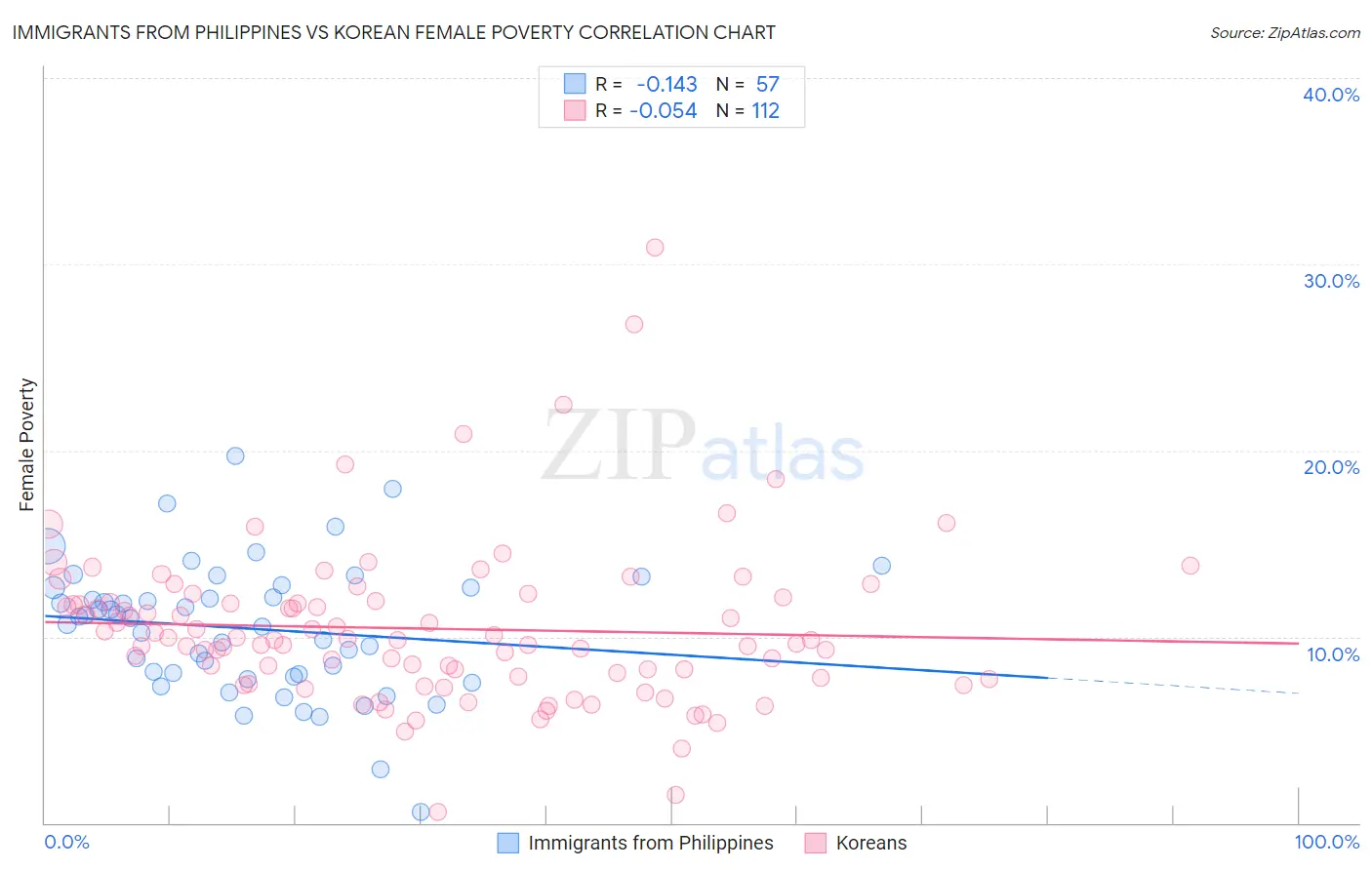Immigrants from Philippines vs Korean Female Poverty
COMPARE
Immigrants from Philippines
Korean
Female Poverty
Female Poverty Comparison
Immigrants from Philippines
Koreans
12.1%
FEMALE POVERTY
98.7/ 100
METRIC RATING
54th/ 347
METRIC RANK
11.9%
FEMALE POVERTY
99.2/ 100
METRIC RATING
43rd/ 347
METRIC RANK
Immigrants from Philippines vs Korean Female Poverty Correlation Chart
The statistical analysis conducted on geographies consisting of 470,914,700 people shows a poor negative correlation between the proportion of Immigrants from Philippines and poverty level among females in the United States with a correlation coefficient (R) of -0.143 and weighted average of 12.1%. Similarly, the statistical analysis conducted on geographies consisting of 510,221,953 people shows a slight negative correlation between the proportion of Koreans and poverty level among females in the United States with a correlation coefficient (R) of -0.054 and weighted average of 11.9%, a difference of 1.5%.

Female Poverty Correlation Summary
| Measurement | Immigrants from Philippines | Korean |
| Minimum | 0.57% | 0.57% |
| Maximum | 19.7% | 30.9% |
| Range | 19.2% | 30.3% |
| Mean | 10.4% | 10.4% |
| Median | 11.0% | 9.8% |
| Interquartile 25% (IQ1) | 7.9% | 7.9% |
| Interquartile 75% (IQ3) | 12.6% | 11.9% |
| Interquartile Range (IQR) | 4.7% | 4.0% |
| Standard Deviation (Sample) | 3.5% | 4.3% |
| Standard Deviation (Population) | 3.5% | 4.3% |
Demographics Similar to Immigrants from Philippines and Koreans by Female Poverty
In terms of female poverty, the demographic groups most similar to Immigrants from Philippines are Immigrants from Austria (12.0%, a difference of 0.14%), Immigrants from Croatia (12.0%, a difference of 0.15%), Immigrants from Sri Lanka (12.1%, a difference of 0.35%), Immigrants from Bulgaria (12.0%, a difference of 0.45%), and Estonian (12.1%, a difference of 0.60%). Similarly, the demographic groups most similar to Koreans are Czech (11.9%, a difference of 0.040%), Immigrants from Moldova (11.9%, a difference of 0.040%), Tongan (11.9%, a difference of 0.070%), Immigrants from Czechoslovakia (11.9%, a difference of 0.16%), and Turkish (11.9%, a difference of 0.16%).
| Demographics | Rating | Rank | Female Poverty |
| Russians | 99.3 /100 | #38 | Exceptional 11.8% |
| Immigrants | Poland | 99.3 /100 | #39 | Exceptional 11.8% |
| Macedonians | 99.3 /100 | #40 | Exceptional 11.8% |
| Czechs | 99.2 /100 | #41 | Exceptional 11.9% |
| Immigrants | Moldova | 99.2 /100 | #42 | Exceptional 11.9% |
| Koreans | 99.2 /100 | #43 | Exceptional 11.9% |
| Tongans | 99.2 /100 | #44 | Exceptional 11.9% |
| Immigrants | Czechoslovakia | 99.2 /100 | #45 | Exceptional 11.9% |
| Turks | 99.2 /100 | #46 | Exceptional 11.9% |
| Asians | 99.1 /100 | #47 | Exceptional 11.9% |
| Immigrants | Japan | 99.0 /100 | #48 | Exceptional 11.9% |
| Immigrants | Romania | 99.0 /100 | #49 | Exceptional 12.0% |
| Slovenes | 98.9 /100 | #50 | Exceptional 12.0% |
| Immigrants | Bulgaria | 98.9 /100 | #51 | Exceptional 12.0% |
| Immigrants | Croatia | 98.7 /100 | #52 | Exceptional 12.0% |
| Immigrants | Austria | 98.7 /100 | #53 | Exceptional 12.0% |
| Immigrants | Philippines | 98.7 /100 | #54 | Exceptional 12.1% |
| Immigrants | Sri Lanka | 98.5 /100 | #55 | Exceptional 12.1% |
| Estonians | 98.3 /100 | #56 | Exceptional 12.1% |
| Immigrants | Serbia | 98.3 /100 | #57 | Exceptional 12.1% |
| Scandinavians | 98.2 /100 | #58 | Exceptional 12.1% |